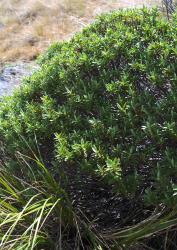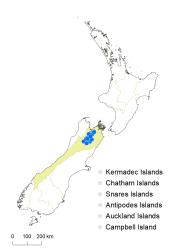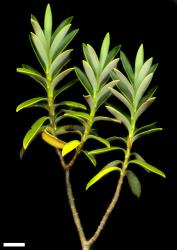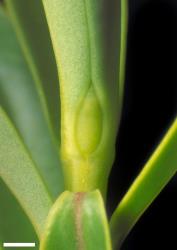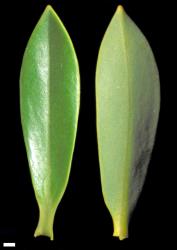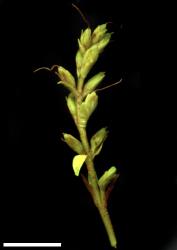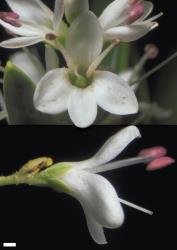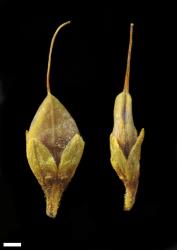- ≡ Hebe cryptomorpha Bayly, Kellow, G.Harper & Garn.-Jones in Bayly et al., New Zealand J. Bot. 40: 596 (2002)
Spreading low or bushy shrub to 1.2 m tall. Stems spreading to ascending to erect, eglandular-pubescent; hairs bifarious, sometimes sparse. Leaf bud distinct, its outer leaves appressed at margins until fully grown; sinus acute. Leaves opposite-decussate, usually erecto-patent, becoming reflexed with age; lamina coriaceous, narrowly oblanceolate to obovate, sometimes elliptic, 7–33 mm long, 3–9 mm wide, dull or somewhat glossy green above, dull and glaucous or glaucescent beneath; midrib evident; surfaces glabrous except midrib pubescent or puberulent above, sometimes only towards base; margin glabrous, minutely papillate, entire or very rarely with 1–3 pairs of shallow teeth, these sometimes with minute glandular hairs in sinus; apex sub-acute to acute and plicate-acuminate; base cuneate; petiole 1–6 mm long. Inflorescence a lateral raceme or spike, rarely tripartite, 12–37 mm long; flowers crowded, 5–17, female or bisexual on separate plants, ⚥ ≥ ♀; bracts opposite, lanceolate, ovate, or deltoid, > pedicels; pedicels absent or erect, 0–5 mm long, eglandular-hairy all around. Calyx lobes 4, anterior usually free or sometimes partly to completely fused, acute to obtuse, 1.5–3 mm long, sub-equal, mixed glandular- and eglandular-ciliolate. Corolla 5–9 mm diameter, ⚥ > ♀; tube white, 1.5–3.0 mm long, slightly < to slightly > calyx, glabrous; lobes 4, white, erecto-patent to recurved, sub-equal, elliptic to ovate, 3–5 mm long, obtuse; nectar guides absent. Stamen filaments white, 3.5–5.5 mm long; anthers dark pink to purplish. Style glabrous, 3.0–6.5 mm long. Capsules latiseptate, obtuse to sub-acute, glabrous or sometimes sparsely eglandular-hairy along groove, 3–4 mm long, 2.4–2.8 mm wide. Seeds oblong, flattened, smooth, straw-yellow to brown, c. 1.1 mm long.
V. cockayneana, V. cryptomorpha, and V. simulans are three very similar species. They are characterised by discolorous leaves (green above and glaucous to glaucescent beneath), an acute leaf bud sinus, coarse bifarious hairs on stem internodes, simple (rarely tripartite) inflorescences with opposite-decussate flowers, corolla tube shorter than or about equal to the calyx, and obtuse corolla lobes.
V. cockayneana occurs in southern New Zealand and mostly has shorter and broader, more elliptic leaves than V. cryptomorpha.
V. simulans is very hard to separate morphologically from V. cryptomorpha, but its leaves are often smaller and more often shallowly toothed. Separate species status is supported by their different chromosome numbers and flavonoid chemistry, combined with their allopatric distributions.
South Island: Sounds Nelson (Richmond Range), Westland (Nelson Lakes National Park), Marlborough (Wairau Mountains, north of Island Pass, and west of Saxton Valley).
Sub-alpine grassland and shrub-land, sometimes among rocks and boulder fields. Recorded elevations range from 1220 to 1677 m.
Flowers: December–February; fruits: January–March, persisting all year.
2n = 40 (see Bayly & Kellow 2006, as Hebe cryptomorpha).
Veronica cryptomorpha is classified in V. subg. Pseudoveronica sect. Hebe and the informal group “Apertae” (small-leaved) (Albach & Meudt 2010; Bayly & Kellow 2006). The phylogenetic relationships of V. cryptomorpha are not clear, but its morphology suggests a close relationship with V. simulans and V. cockayneana, and perhaps other species that are characterised by glaucous leaves. This is not contradicted by ITS sequence data (E.M. Low, unpublished).
The seed description is based on limited material and might not represent the range present.



